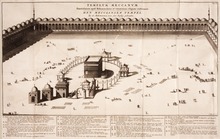| Banu Adnan بنو عدنان | |
|---|---|
| Qedarite branch of the Ishmaelites | |
 View of Kaaba in 1718, which was previously ruled by the Quraysh tribe of 'Adnanites' in Pre-Islamic Arabia View of Kaaba in 1718, which was previously ruled by the Quraysh tribe of 'Adnanites' in Pre-Islamic Arabia | |
| Nisba | al-Adnani (masculine) al-Adnaniyyah (feminine) |
| Location | Western Arabia, Hejaz region (present-day Saudi Arabia) |
| Descended from | Adnan |
| Religion | Islam Pre-Islamic Arabia: Hanif, Indigenous polytheistic Arabian religion Minority: Christianity (Nestorianism), Judaism, Zoroastrianism, later on |
The Adnanites (Arabic: عَدْنَانِيُّون, romanized: ʿadnāniyyūn) were a tribal confederation of the Ishmaelite Arabs, who trace their lineage back to Ishmael son of the Islamic prophet and patriarch Abraham and his wife Hagar through Adnan, who originate from the Hejaz. The Islamic prophet Muhammad belonged to the Quraysh tribe of the 'Adnanites'.
According to the Arab tradition, The Adnanites are the Northern Arabs, unlike the Qahtanite Arabs of southern Arabia, who are descended from Qahtan, son of the Islamic prophet Hūdʿ.
Arab genealogical tradition
See also: Tribes of Arabia

According to Arab genealogical tradition, the Adnanites are descended from Adnan whom in turn is descended from Ishmael. whereas the Qahtanites of Southern Arabia (Yemen) are the original, pure Arabs.
Modern historiography
According to some modern historians, the traditional distinction between Adnanites and Qahtanites lacks evidence and may have developed out of the later faction-fighting during the Umayyad period.
Further reading
- The dwelling places and wanderings of the Arabian tribes, by Heinrich Ferdinand Wüstenfeld, in German
- Were the Qays and Yemen of the Umayyad Period Political Parties?
See also
- Prophet Muhammad, a member of this group
References
- al-Bakri, Abdullah. Mu'jam mā ista'jam. Vol. 1. p. 87.
- "Family Tree of Muhammad". 26 December 2018.
- ^ Parolin, Gianluca P. (2009). Citizenship in the Arab World: Kin, Religion and Nation-State. Amsterdam University Press. p. 30. ISBN 978-9089640451.
- Parolin, Gianluca P. (2009). Citizenship in the Arab World: Kin, Religion and Nation-State. Amsterdam University Press. p. 30. ISBN 978-9089640451.
The 'arabicised or arabicising Arabs', on the contrary, are believed to be the descendants of Ishmael through Adnan, but in this case the genealogy does not match the Biblical line exactly. The label "arabized" has come about due to the belief that Ishmael spoke Hebrew until he got to Mecca, where he married a Yemeni woman and learnt Arabic. Both genealogical lines go back to Sem, son of Noah, but only Adnanites can claim Abraham as their ascendant, and the lineage of Mohammed, the Seal of Prophets (khatim al-anbiya'), can therefore be traced back to Abraham. Contemporary historiography unveiled the lack of inner coherence of this genealogical system and demonstrated that it finds insufficient matching evidence; the distinction between Qahtanites and Adnanites is even believed to be a product of the Umayyad Age, when the war of factions (al-niza al-hizbi) was raging in the young Islamic Empire.
- Reuven Firestone (1990). Journeys in Holy Lands: The Evolution of the Abraham-Ishmael Legends in Islamic Exegesis. SUNY Press. p. 72. ISBN 9780791403310.
- Göran Larsson (2003). Ibn García's Shuʻūbiyya Letter: Ethnic and Theological Tensions in Medieval al-Andalus. BRILL. p. 170. ISBN 9004127402.
- Charles Sanford Terry (1911). A Short History of Europe, from the fall of the Roman empire to the fall of the Eastern empire. Taylor & Francis. ISBN 978-1112467356. Retrieved 4 February 2013.
- Luwīs ʻAwaḍ (1987). The Literature of ideas in Egypt, Part 1. Indiana University. p. 146. ISBN 978-1555400651. Retrieved 4 February 2013.